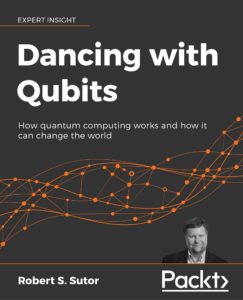
This morning I awoke to a very nice email from Tom Jacob, the Project Editor for my book at Packt Publishing. He said, in part,
We were able to successfully ship the book to our printers. …
Congratulations on achieving this milestone!
As I’ve mentioned before, my book was prepared using LaTeX and not Microsoft Word. I gave the publishers what was essentially the “camera-ready” PDF file from which to print. Hence the part about being able to “successfully ship” the book. In fact, I sent them the final PDF last night. I thought I was done on Friday, but yesterday I noticed an out-of-place citation in the section on the Bloch sphere and did a quick fix.
Now that the book is in production and there is absolutely nothing else I can do to fiddle with it, I’m going to show you the table of contents. I tried to have fun with some of the chapter and section titles. Once the book is published, I’ll be happy to discuss why I included this content or that.
Dancing with Qubits
How quantum computing works and
how it can change the world
Preface ix
1Â Why Quantum Computing? 1
1.1 The mysterious quantum bit 2
1.2 I’m awake! 4
1.3 Why quantum computing is different 7
1.4 Applications to artificial intelligence 9
1.5 Applications to financial services 15
1.6 What about cryptography? 18
1.7 Summary 21
IÂ Foundations 23
2 They’re Not Old, They’re Classics 25
2.1 What’s inside a computer? 26
2.2 The power of two 32
2.3 True or false? 33
2.4 Logic circuits 36
2.5 Addition, logically 39
2.6 Algorithmically speaking 42
2.7 Growth, exponential and otherwise 42
2.8 How hard can that be? 44
2.9 Summary 55
3Â More Numbers than You Can Imagine 57
3.1 Natural numbers 58
3.2 Whole numbers 60
3.3 Integers 62
3.4 Rational numbers 66
3.5 Real numbers 73
3.6 Structure 88
3.7 Modular arithmetic 94
3.8 Doubling down 96
3.9 Complex numbers, algebraically 97
3.10 Summary 103
4Â Planes and Circles and Spheres, Oh My 107
4.1 Functions 108
4.2 The real plane 111
4.3 Trigonometry 122
4.4 From Cartesian to polar coordinates 129
4.5 The complex “plane†129
4.6 Real three dimensions 133
4.7 Summary 134
5Â Dimensions 137
5.1 R2 and C1 139
5.2 Vector spaces 144
5.3 Linear maps 146
5.4 Matrices 154
5.5 Matrix algebra 166
5.6 Cartesian products 176
5.7 Length and preserving it 177
5.8 Change of basis 189
5.9 Eigenvectors and eigenvalues 192
5.10 Direct sums 198
5.11 Homomorphisms 200
5.12 Summary 204
6 What Do You Mean “Probably� 205
6.1 Being discrete 206
6.2 More formally 208
6.3 Wrong again? 209
6.4 Probability and error detection 210
6.5 Randomness 212
6.6 Expectation 215
6.7 Markov and Chebyshev go to the casino 217
6.8 Summary 221
IIÂ Quantum Computing 223
7Â One Qubit 225
7.1 Introducing quantum bits 226
7.2 Bras and kets 229
7.3 The complex math and physics of a single qubit 234
7.4 A non-linear projection 241
7.5 The Bloch sphere 248
7.6 Professor Hadamard, meet Professor Pauli 253
7.7 Gates and unitary matrices 265
7.8 Summary 266
8Â Two Qubits, Three 269
8.1 Tensor products 270
8.2 Entanglement 275
8.3 Multi-qubit gates 283
8.4 Summary 295
9Â Wiring Up the Circuits 297
9.1 So many gates 298
9.2 From gates to circuits 299
9.3 Building blocks and universality 305
9.4 Arithmetic 315
9.5 Welcome to Delphi 322
9.6 Amplitude amplification 324
9.7 Searching 330
9.8 The Deutsch-Jozsa algorithm 338
9.9 Simon’s algorithm 346
9.10 Summary 354
10Â From Circuits to Algorithms 357
10.1 Quantum Fourier Transform 358
10.2 Factoring 369
10.3 How hard can that be, again 379
10.4 Phase estimation 382
10.5 Order and period finding 388
10.6 Shor’s algorithm 396
10.7 Summary 397
11Â Getting Physical 401
11.1 That’s not logical 402
11.2 What does it take to be a qubit? 403
11.3 Light and photons 406
11.4 Decoherence 415
11.5 Error correction 423
11.6 Quantum Volume 429
11.7 The software stack and access 432
11.8 Simulation 434
11.9 The cat 439
11.10 Summary 441
12Â Questions about the Future 445
12.1 Ecosystem and community 446
12.2 Applications and strategy 447
12.3 Access 448
12.4 Software 449
12.5 Hardware 450
12.6 Education 451
12.7 Resources 452
12.8 Summary 453
Afterword 455
Appendices 458
AÂ Quick Reference 459
A.1 Common kets 459
A.2 Quantum gates and operations 460
BÂ Symbols 463
B.1 Greek letters 463
B.2 Mathematical notation and operations 464
CÂ Notices 467
C.1 Creative Commons Attribution 3.0 Unported (CC BY 3.0) 467
C.2 Creative Commons Attribution-NoDerivs 2.0 Generic (CC BY-ND 2.0) 468
C.3 Creative Commons Attribution-ShareAlike 3.0 Unported (CC BY-SA 3.0) 468
C.4 Los Alamos National Laboratory 469
C.5 Trademarks 469
DÂ Production Notes 471
Other Books You May Enjoy 473
Index 477
Changes, clarifications, and errata
Previous: Drawing quantum circuits
Next: What about the eBook?
| In December, 2019, Packt Publishing published my book Dancing with Qubits: How quantum computing works and how it can change the world. Through a series of blog entries, I talk about the writing and publishing process, and then about the content. |

